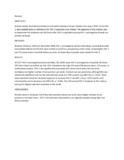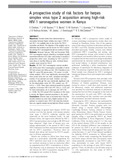| dc.description.abstract | OBJECTIVES:
Several studies have demonstrated an association between herpes simplex virus type 2 (HSV-2) and HIV-1, but available data on risk factors for HSV-2 acquisition are limited. The objective of this analysis was to determine the incidence and risk factors for HSV-2 acquisition among HIV-1-seronegative female sex workers in Kenya.
METHODS:
Between February 1993 and December 2006, HIV-1-seronegative women attending a municipal sexually transmitted infection (STI) clinic were invited to enroll in a prospective cohort study. Screening for HIV-1 and STIs were done at monthly follow-up visits. Archived blood samples were tested for HSV-2.
RESULTS:
Of 1527 HIV-1-seronegative women enrolled, 302 (20%) were HSV-2 seronegative at baseline of whom 297 had at least one follow-up visit. HSV-2 incidence was high (23 cases/100 person-years; 115 cases). In multivariate analysis, HSV-2 was significantly associated with more recent entry into sex work, workplace and higher number of sex partners per week. Condom use was protective, although this was statistically significant only for the intermediate strata (25-75% condom use; HR 0.43; p = 0.05). There were statistical trends for bacterial vaginosis to increase HSV-2 risk (HR 1.56; p = 0.07) and for oral contraceptive use to decrease risk (HR 0.50; p = 0.08). The 23% annual HSV-2 incidence in this study is among the highest reported anywhere in the world.
CONCLUSIONS:
Women were at increased risk if they had recently entered sex work, had a higher number of sex partners or worked in bars. HSV-2 risk reduction interventions are urgently needed among high-risk African women. | en |


